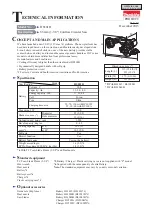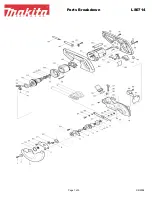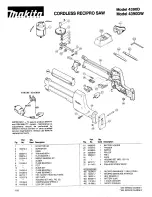
POWX221
EN
Copyright © 2017 VARO
P a g e
|
8
www.varo.com
7.3
Assemble undercarriage Fig. G
Turn the machine upside down.
Remove the black plastic bottom plate by unscrewing the 6 screws. (Fig. G-1).
Unscrew the adjusting knob on the front and tilt the motor (Fig. G-2), then remove the
transport packing (Fig. G-3).
Now place one by one the uprights in the casing of the sawing bench (Fig. G-4).
Secure the uprights with 4 screws using a screwdriver, do not completely tighten the
screws (Fig. G-5).
Fit the 4 support bars, do not completely tighten the screws (Fig. G-6)
Fit the black plastic bottom plate and screw it tight.
Attach the rubber feet under the uprights (Fig. G-7).
Turn the machine into an upright position on a flat surface and adjust the machine so that
it stands in a stable position, tighten all the nuts and bolts (Fig. G-7).
7.4
Assemble bracket/push stick.
Attach the 2 brackets onto t he casing of the sawing bench and screw them tight (Fig. G-
8).
Place the push stick in the brackets.
7.5
Assembly and attachment of the rip fence Fig. D
Attach the aluminium fence (A) to the positioning block (B).
Now you can attach the complete rip fence to the bench top.
Slide the rip fence via one end of the positioning rail (C) over the bench top.
Adjust the position of the aluminium fence profile (A) such that the end corresponds to the
rear edge of the saw.
7.6
Assembly of the riving knife and the protective cap Fig. E
Turn the saw blade completely upwards.
Remove the bench inlay.
Assemble the riving knife on the set-up for this purpose and use hereby the Allen screws
and the filling rings. Ensure that the riving knife falls properly into the opening (= groove).
Now put the inlay back in the bench and fasten it.
Now assembly the protective cap onto the riving knife and use hereby the profiled nut and
self-locking nut.
Now lay a lath against the saw blade and the riving knife and check whether
it falls properly into the extension of the saw blade. If this is not the
case:Loosen the fastening bolts and place or remove the filling rings.
Above the saw table the radial distance between the riving knife and the toothed rim of the
saw blade shall not at any point exceed 5 mm at the depth of cut set.
The tip of the riving knife shall not be lower than 5 mm from the tooth peak, as shown.
7.7
Assembly of the saw blade
First remove the plug from the mains before the saw blade is assembled or
replaced.
Remove the inlay from the bench. Use a screwdriver for this purpose.
Turn the saw axle completely upwards. Remove the nut and the outside flange from the
saw axle.
Now slide the saw blade over the saw axle and now put the outside flange and the nut
back. Tighten the nut by hand.































